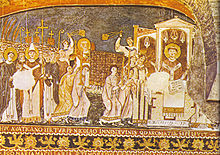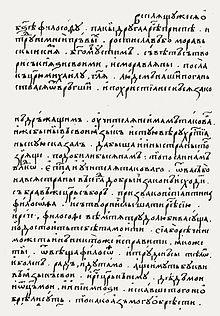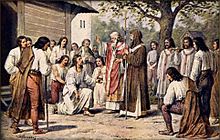Life of constantine

The life of Constantine is a saints vita about the life of the Slav apostle Kyrill von Saloniki , whose real name is Constantine . In the text of the legend he is called the philosopher . It is a script of great literary and historical importance. It is one of the oldest written evidence in the Old Church Slavonic language .
There is a similar, shorter vitae of saints about his brother Method , the life of Method . Both vites are collectively referred to as Pannonian legends because of the earlier assumption that they were written in Pannonia by students of the two Slav apostles.
Author and dating
The Life of Constantine was probably written in Greater Moravia at the end of the 9th century , between the years 869 (the death of Constantine) and 882 (the death of Pope John VIII ), that is, while Methods was still alive.
The Old Church Slavonic literature and liturgy were at their peak in Moravia at this time. The resistance of the Latin part of the Moravian Church to the Slavic liturgy was not yet so strong, the Slavic side was not yet in danger. This is why the life of Constantine does not have as strong an anti-Frankish and apologetic orientation as the life of Method, written after Method's death .
The author is a student of Constantine and Method. Some historians assume that Kliment von Ohrid wrote it with the help of Method. But there is also the opinion that both Pannonian legends were written by the students of the Slav apostles only after their expulsion from Moravia in Pannonia or Bulgaria in the 10th century.
Manuscripts and publications
From the Life of Constantine 59 are manuscripts Russian or South Slavic origin known. The oldest manuscript dates from the 15th century and is in the collection of the Moscow Spiritual Academy.
The two Pannonian legends have often been edited, translated and commented on. The oldest edition comes from PJ Šafárik (1851). J. Perwolf published it in 1873 in the first volume of Prameny dějin českých (“Sources of Czech History”) together with a Czech translation. The last critical editions of the text are by Lavrov (1930) and Grivec - Tomšič (1960). František Dvorník published a historical commentary with a French translation of both legends in 1933. Vavřínek published a historical commentary and extensive bibliography in 1963.
Most of the historical evidence in the life of Constantine is believed to be credible.
construction
The structure corresponds in its main features to the hagiographic scheme of Byzantine legends. But the focus is not on portraying miracles. The aim is to justify Constantine's Moravian mission theologically. The text therefore contains a large number of biblical quotations and paraphrases of biblical texts. It should become clear that Constantine is a holy man chosen by God and gifted with an extraordinary talent. He is called by God for the mission in Moravia. His work - namely the creation of the Slavic script and the introduction of the Slavic liturgy - fully corresponds to the Holy Scriptures and the interests of the Church. The author wants to achieve this with two means:
- First, with detailed descriptions of Constantine's theological disputations . Here Constantine shows himself to be a profound expert on the Scriptures, who knows how to defend the Christian faith against all adversaries. These disputations take up about half of the entire text. First Constantine defends the faith against the heretics within the Church in Constantinople (dispute with Patriarch Ioannés in Chapter 5), then against those of different faiths ( Saracens in Chapter 6 and Jews in Chapter 9-11) and finally he defends the Slavic liturgy the Latin clergy in Venice (chap. 16).
- The second means by which the author wants to prove Constantine's calling is the hagiographic framework. The biographer describes Constantine as a saint who is under a special divine favor and who carries out his mission with God's help. This is shown in the supernatural events that accompany his work and in the extraordinary abilities that are attributed to him. This “miraculous” component plays a subordinate role, however, the miracles are only mentioned briefly.
It is noticeable that the author always associates Constantine's work with books. Constantine learns the writings of Saint Gregory by heart (chap. 3), in the monastery on Mount Olympus he studies books (chap. 7), on his mission in Cherson he reads Hebrew, Samaritan and Syrian books (chap. 8), in chap. 9 he declares books to be the only true source of knowledge. In his conversation with the Byzantine emperor in the Cape. 14 he made the existence of Slavic books a necessary condition of his mission in Moravia. All of these descriptions are intended to show the necessity of the Slavic script created by Constantine.
The life of Constantine is supposed to justify the Slavic liturgy and thus the existence of the Slavic Church in Greater Moravia theologically and to justify it to the Latin clergy. The strongest argument in Chap. 18 the reference to the fact that Constantine's translation of the Holy Scriptures and the liturgical books was approved by the Pope and that after Constantine's death the Pope even allowed his bones to be worshiped. This also shows the fundamentally positive attitude of the Moravian Slavic Church towards the papacy.
content
" LIFE OF ST. KONSTANTIN - KYRILL
On the 14th day of February.
Memory and life of our holy teacher, Constantine the Philosopher, the first educator and teacher of the Slavic people "
- Cape. 1 ( prologue )
- The prologue provides the theological justification for the work: The saint should serve as an example. It closes with the words: “Follow me as I follow Christ” (cf. ( 1 Cor 4:16 EU )).
- Cape. 2-4
- Constantine was born in Thessaloniki into a wealthy family as the youngest of seven siblings. Even in his childhood surpasses everyone in wisdom and piety. At the University of Constantinople, he quickly acquired all the knowledge that was available to him. He refuses marriage and high office and only wants to devote himself to spiritual life and study. He escapes to a monastery. Later, at the request of the Empress, he accepted a professorship at the university.
- Cape. 5-13
- In his first theological disputation, Constantine defended the worship of icons . He is then sent by the emperor to the Saracens , where he represents the Christian faith towards the Islamic scholars. Then he gives away all his possessions and goes to his brother Method in a monastery. But soon afterwards he is sent by the emperor as a missionary to the Khazars . His theological disputations with the Jews there are described in detail. With God's help, Constantine found Pope Clement's grave in Cherson and took his bones with him.
- Cape. 14-15
- Rastislav , Prince of Moravia, turns to the Byzantine emperor with the request for a bishop and teacher to instruct his people in the Christian faith.
“ Our people have already rejected paganism and abide by Christian laws; but we have no teachers who can instruct us in the correct Christian faith in our language, so that other peoples, when they see it, emulate us; so send us, Lord, a bishop and teacher. For a good law is spreading from you to all countries. "
- The emperor selects Constantine for this mission. God reveals to Constantine a script for the Slavic language and Constantine translates the Gospel.
" God, who wants everyone to come to a knowledge of the truth and to attain a higher level of knowledge, has seen your faith and your efforts and has revealed a script for your language [...] so that you too can be added to the great peoples, who praise God in their own language. So we send you the one to whom God revealed it [ie the Slavic script], an honorable, orthodox and learned man, a philosopher. Accept this gift that is greater and more honorable than gold, silver and precious stones. "
- In Moravia, Constantine received generous support from Rastislav. He trains students and continues to work on the translations of liturgical texts. But he also has to fight against paganism and has arguments with the Frankish Latin clergy.
“ They said to him,“ You can't worship God like that. If God had willed that, why didn't he cause them to have a script for their language from the start and so worship him? But he only selected three languages, Hebrew, Greek and Latin, only in these is it due to God to give glory. ”Those who spoke in this way were Latin and Frankish priests and students. The philosopher fought with them like David with strangers and defeated them with the words of the Holy Scriptures and called them trilinguals and pilatists, because this is how Pilate wrote the words above the cross of Christ. "

- After 40 months in Moravia, Constantine leaves with his students to have them consecrated. On the way he is received by Pannonian prince Kocel , he entrusts him with 50 pupils for training as a priest.
- Cape. 16-17
- On the way in Venice, Constantine had to defend the introduction of the Slavic written language against the Latin clergy. At the invitation of Pope Hadrian, he traveled on to Rome , where he was generously received. He takes the bones of St. Clemens with. Worship of the relic works miracles, healings occur, and prisoners are released. Pope consecrates the Slavic books. Constantine's students are ordained priests and then celebrate services in various churches in Rome with the Slavic liturgy.
- Cape. 18th
- Constantine foresees his death, enters the monastery and takes the religious name Cyril. He prays to keep the Moravian Church and after 50 days (February 14th, 869) he dies. He is buried in St. Clement's Basilica in Rome. He is venerated as a saint by the Romans, and miracles happen at his grave.
“ After these words he died in the Lord at the age of 42 years, on the 14th day of February, in the second indiction , in the year 6377 since the creation of the world. [...] They placed him with the coffin on the right side of the altar in the Basilica of St. Clemens [...] They painted his picture over the grave and began to light a light there day and night and praised God. "
Remarks
- ↑ day of death
- ↑ a b c d e Translation into German based on the Czech text in: Josef Vašica: Literární památky epochy velkomoravské 863 - 885 . Vyšehrad, Praha 1996, ISBN 80-7021-169-5 , p. 227-257 (Czech, 340 pp.).
- ↑ Pontius Pilate wrote the words "Jesus of Nazareth, King of the Jews" in these three languages above the cross of Christ . Cf. ( Joh 19,19-20 EU ).
- ↑ D. h. on February 14, 869, based on the traditional creation date 5508 BC. Chr.
- ↑ The grave of St. Constantine is now in the Basilica of San Clemente al Laterano in Rome. It was developed as a pilgrimage destination by the Orthodox Church. See also: Josef Vašica: Literární památky epochy velkomoravské 863 - 885 . Vyšehrad, Praha 1996, ISBN 80-7021-169-5 , p. 276 (Commentary on Chapter 18) (Czech, 340 pp.).
literature
- Johannes Karayannopulos; Günter Weiß: Sources for the history of Byzantium (324-1453) , Wiesbaden 1982, pp. 348-349 No. 221 ISBN 3-447-02244-2
- Josef Bujnoch: Between Rome and Byzantium: Life and work of the Slavic apostles Kyrillos and Methodios according to the Pannonian legends and the Klemensvita: Report of the baptism of Russia according to the Laurentius Chronicle . Styria, Graz – Vienna – Cologne, 2 1972 (Slavic historians, 1)
- Vladimír Vavřínek: Staroslověnské životy Konstantina a Metoděje (= Old Church Slavonic life of Constantine and Method) . In: Rozpravy Československé Akademie Věd . Nakladatelství Československé Akademie Věd (NČSAV), Praha 1963 (Czech, 123 pages, with a French resume).
- Josef Vašica: Literární památky epochy velkomoravské 863 - 885 (= literary monuments of the Great Moravian epoch 863 - 885) . Vyšehrad, Praha 1996, ISBN 80-7021-169-5 (Czech, 340 pages).
- Radoslav Večerka: Staroslověnská etapa českého písemnictví (= Old Church Slavonic stage of Czech literature) . Nakladatelství Lidové Noviny, Praha 2010, ISBN 978-80-7422-044-9 (Czech, 176 pages).
- Francis Dvorník : Byzantine Mission among the Slavs: SS. Constantine-Cyril and Methodius . Rutgers University Press, New Brunswick, New Jersey 1970, ISBN 0-8135-0613-1 (English, 484 pages).
- Francis Dvorník: Les legends de Constantin et de Méthode vues de Byzance . Orbis, Praha 1933 (French, 443 pages).
- PA Lavrov: Materialy po istorii vozniknovenija drevnejšej slavjanskoj pismennosti (= materials on the genesis of the oldest Slavic literature) . Akademija Nauk SSSR, Leningrad 1930 (Russian, 200 pp., 1-66 (Life of Constantine), 67-78 (Life of Method)).
- F. Grivec, F. Tomšič: Konstantin i Methodije Solunjani, Izvori; Constantinus et Methodius Thessalonicenses, Fontes . Radovi Staroslovenskog Instituta, knjiga 4. Zagreb 1960. (Serbo-Croatian, Church Slavonic)
Individual evidence
- ↑ a b Vladimír Vavřínek: Staroslověnské životy Konstantina a Metoděje . In: Rozpravy Československé Akademie Věd . Nakladatelství Československé Akademie Věd (NČSAV), Prague 1963, p. 80–84 (Czech, 123 p., With French resume).
- ↑ a b c d Josef Vašica: Literární památky epochy velkomoravské 863–885 . Vyšehrad, Praha 1996, ISBN 80-7021-169-5 , p. 95-97, 101-102 (Czech, 340 pp.).
- ↑ a b Radoslav Večerka: Staroslověnská etapa českého písemnictví . Nakladatelství Lidové Noviny, Praha 2010, ISBN 978-80-7422-044-9 , p. 71 (Czech, 176 pp.).
- ↑ a b Vladimír Vavřínek: Staroslověnské životy Konstantina a Metoděje . In: Rozpravy Československé Akademie Věd . Nakladatelství Československé Akademie Věd (NČSAV), Prague 1963, p. 3–9 (Czech, 123 p., With French resume).
- ↑ PA Lavrov: Materialy po istorii vozniknovenija drevnejšej slavjanskoj pismennosti (= materials on the genesis of the oldest Slavic literature) . Akademija Nauk SSSR, Leningrad 1930 (Russian, 200 pp., Pp. 1–66 (Life of Constantine), pp. 67–78 (Life of Method)).
- ↑ F. Grivec, F. Tomšič: Konstantin i Methodije Solunjani, Izvori; Constantinus et Methodius Thessalonicenses, Fontes . Radovi Staroslovenskog Instituta, knjiga 4. Zagreb 1960. (Serbo-Croatian, Church Slavonic)
- ^ Francis Dvorník: Les legends de Constantin et de Méthode vues de Byzance . Orbis, Praha 1933 (French, 443 pages).
- ↑ Vladimír Vavřínek: Staroslověnské životy Konstantina a Metoděje . In: Rozpravy Československé Akademie Věd . Nakladatelství Československé Akademie Věd (NČSAV), Praha 1963 (Czech, 123 pages, with a French resume).
- ↑ Vladimír Vavřínek: Staroslověnské životy Konstantina a Metoděje . In: Rozpravy Československé Akademie Věd . Nakladatelství Československé Akademie Věd (NČSAV), Prague 1963, p. 53, 63 (Czech, 123 p., With French resume).
Web links
- Život sv. Konstantina (Life of St. Constantine) . In: Josef Emler (ed.): Fontes rerum Bohemicarum I: Vitae Sanctorum et aliorum quorundam pietate insignium. Chapter I: Life of St. Constantine (Pannonian legend) . Prague 1873, p. 1–38 ( online [accessed June 3, 2020] in Cyrillic and Czech).
- Život sv. Konstantina-Cyrila (Life of St. Konstantin-Kyrill) . (Czech, in moraviamagna [accessed January 25, 2017] with comments by Josef Vašica, 1966).
- Life of Constantine excerpts from the Pannonian legend. Retrieved January 25, 2017
- Tomb of St. Kyrill Website of the San Clemente Basilica (English and Italian). Retrieved November 6, 2017


